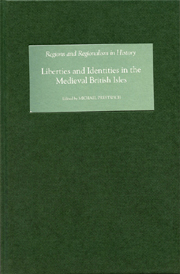Book contents
- Frontmatter
- Contents
- List of maps
- Abbreviations
- Introduction
- 1 States, liberties and communities in medieval Britain and Ireland (c.1100–1400)
- 2 Arbitration and Anglo-Scottish border law in the later middle ages
- 3 Peacekeepers and lawbreakers in medieval Northumberland, c.1200–c.1500
- 4 War, lordship, and community in the liberty of Norhamshire
- 5 The lordship of Richmond in the later middle ages
- 6 ‘Tam infra libertates quam extra’: Liberties and military recruitment
- 7 Neighbours from Hell? Living with Tynedale and Redesdale, 1489–1547
- 8 Striving for Marcher liberties: The Corbets of Caus in the thirteenth century
- 9 Franchises north of the border: Baronies and regalities in medieval Scotland
- 10 The liberties of Ireland in the reign of Edward I
- Index
2 - Arbitration and Anglo-Scottish border law in the later middle ages
Published online by Cambridge University Press: 12 September 2012
- Frontmatter
- Contents
- List of maps
- Abbreviations
- Introduction
- 1 States, liberties and communities in medieval Britain and Ireland (c.1100–1400)
- 2 Arbitration and Anglo-Scottish border law in the later middle ages
- 3 Peacekeepers and lawbreakers in medieval Northumberland, c.1200–c.1500
- 4 War, lordship, and community in the liberty of Norhamshire
- 5 The lordship of Richmond in the later middle ages
- 6 ‘Tam infra libertates quam extra’: Liberties and military recruitment
- 7 Neighbours from Hell? Living with Tynedale and Redesdale, 1489–1547
- 8 Striving for Marcher liberties: The Corbets of Caus in the thirteenth century
- 9 Franchises north of the border: Baronies and regalities in medieval Scotland
- 10 The liberties of Ireland in the reign of Edward I
- Index
Summary
One of the defining characteristics of medieval liberties was their distinct status as geographically specific territories within which, as the jingle goes, the king's writ did not run. Some were very small, consisting of only a handful of hundreds; others, like Durham, approximated the size of entire counties. Irrespective of their extent, however, all were also set apart, legally and conceptually, from the areas around them. This second, more fluid notion of liberties as spatially distinct sites forms the context for the study that follows, and the justification for treating the entire Anglo-Scottish border region as a de facto franchise.
The marches of England and Scotland in the later Middle Ages shared many of the features that historians have traditionally associated with ‘genuine’ liberties. The king's writ (or, in Scotland, his brieve) did in fact run there, but from the early years fourteenth century onwards both the English and the Scottish crowns were more likely to send their directives to specially empowered border officials (the wardens of the marches) than to sheriffs, much as the they did when they addressed the bailiffs of liberties rather than shrieval personnel. More tellingly, like the inhabitants of liberties elsewhere in the British Isles, the people who lived in the Anglo-Scottish border lands shared an identity born of political and legal circumstance. Petitions to the English parliament from the ‘poor commons’ of Cumberland or Northumberland, for example, frequently made allusion to the especially dire conditions affecting the lives of the people who lived within the marches, that is, the areas located in greatest proximity to the Scottish enemy.
- Type
- Chapter
- Information
- Liberties and Identities in the Medieval British Isles , pp. 37 - 55Publisher: Boydell & BrewerPrint publication year: 2008



